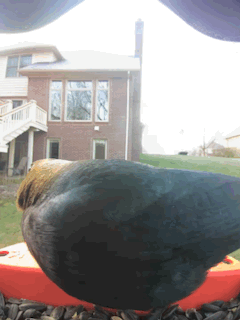The Brown-Headed Cowbird is Fascinating and Controversially Invasive

Bird lovers and nature enthusiasts are no strangers to the invasive Brown-headed Cowbird, a stocky blackbird with a unique and somewhat notorious approach to raising its young. Cowbirds have been around for centuries, but their numbers have increased significantly in recent years, especially as humans build towns and clear woodlands. While these birds are native to North America, many consider them a nuisance since they tend to destroy the eggs and young of smaller songbirds. This post will examine the Brown-headed Cowbird, its behavior, controversies, and its impact on other bird species.
The Brown-headed Cowbird is a medium-sized bird typically measuring six to eight inches long. This bird species has a black body, brown head, and a stout, conical bill. At first, I thought they were named for their similarity in color to a typical cow. It is much more straightforward than that. These birds follow livestock, given their tendency to draw insects to the herd.
Cowbirds are known for laying their eggs in the nests of other bird species, leaving them to be raised by unsuspecting foster parents. The female cowbird will search for nests that are being built or are already in use and eject one of the host’s eggs to lay her own. The cowbird chick will hatch before the others, grow faster, and compete aggressively with the host’s chicks for food. As a result, the host’s chicks may starve, or the parents may abandon the nest altogether.
Although the cowbird’s behavior is intriguing, it is also the cause of much controversy. Many bird enthusiasts and conservationists consider cowbirds to be brood parasites, meaning they harm and reduce the populations of other bird species. Cowbirds target smaller songbirds, such as the endangered Kirtland’s Warbler, directly impacting their breeding success. In contrast, others argue that cowbirds are part of a natural and necessary process of avian evolution, and their behavior should not be demonized.

Despite their notoriety, Brown-headed Cowbirds have unique adaptations that have helped them thrive. They are opportunistic feeders and feed on insects, seeds, fruits, and sometimes even small mammals. Cowbirds are also resistant to some chemicals and can tolerate a wide range of temperatures, making them adaptable to different environments. They’re often found in open grasslands, pastures, and agricultural fields, but they have expanded their habitat to include suburban areas and woodlands with fragmented habitats.
Brown-headed Cowbirds have been a topic of controversy and interest for bird enthusiasts for years. Although their behavior can be seen as parasitic, the cowbird does play a role in nature’s evolution. They survive and thrive in different habitats, and their curious behavior towards fostering their young is a unique adaptation in the avian world.

Conclusion:
The Brown-headed Cowbird is a fascinating bird with a unique approach to raising its young, but not everyone has a positive view of their behavior. Their reputation as brood parasites and the harm inflicted upon other bird species is debated within the birding community. However, as outdoor lovers, it is essential to appreciate the cowbird’s adaptations and behaviors as part of nature’s evolution. These birds continue to thrive in diverse habitats and may serve as a reminder of the adaptive capabilities of birds even in the modern world.